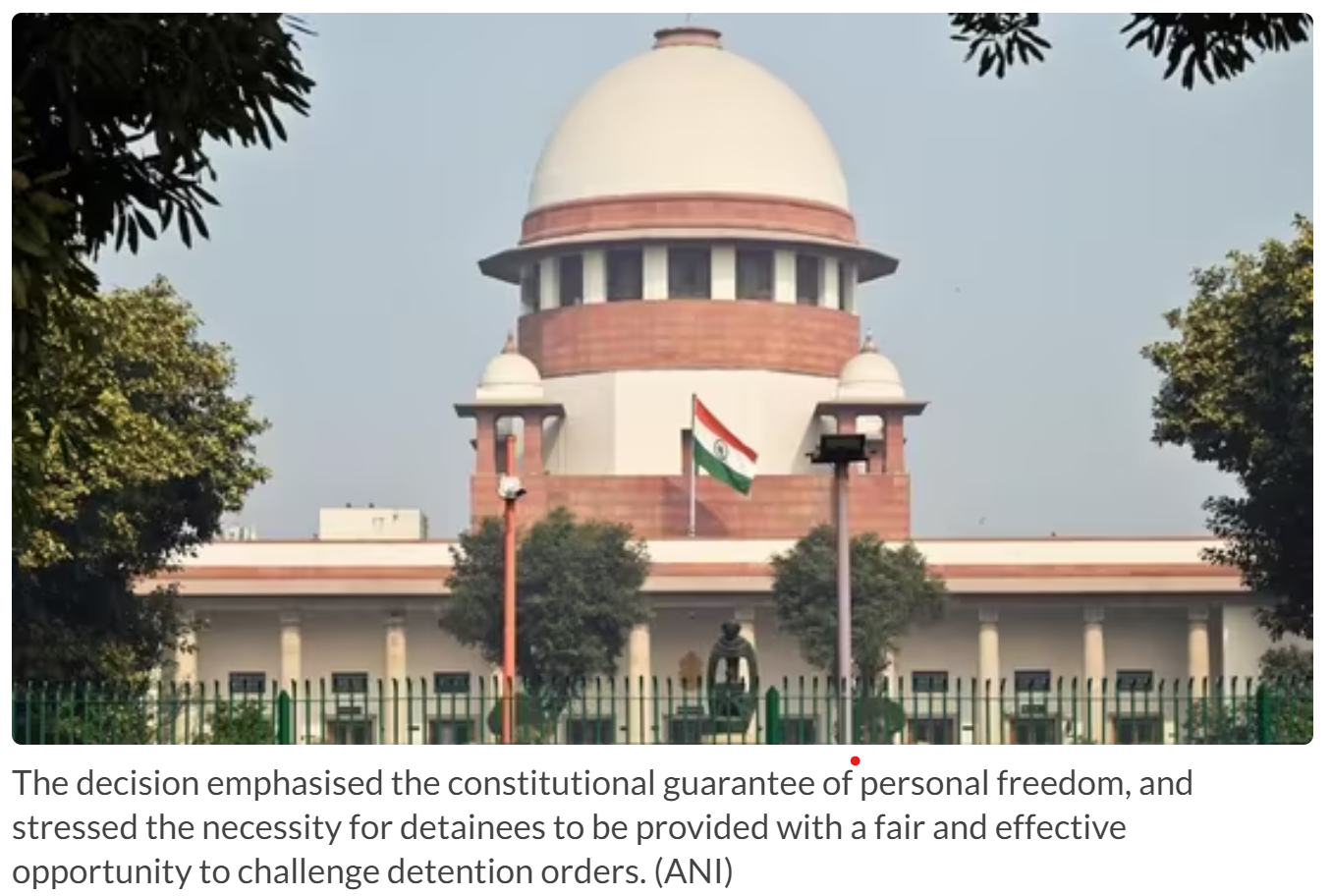Preventive Detention

- 16 Sep 2024
In News:
The recent Supreme Court ruling in Jaseela Shaji vs. Union of India (2024) introduces new standards for preventive detention in India, aiming to strengthen safeguards for individual liberty.
Key Aspects of the Ruling
- Strict Standards for Preventive Detention:
- The Court emphasized the need for authorities to furnish all essential materials relied upon in detention orders to the detainee.
- This includes providing documents in a language the detainee understands to ensure fair representation.
- Constitutional Guarantees:
- The ruling reinforced the constitutional right to personal liberty and the need for a fair process in preventive detention cases, as guaranteed under Article 22(5) of the Constitution.
- The Court asserted that individual freedom is paramount and cannot be curtailed without adherence to due process.
- Importance of Timely Representation:
- The Court criticized the significant delays in handling and deciding the detainee's representation.
- Authorities are mandated to act with “utmost expedition” in processing and deciding representations related to personal liberty.
- Case-Specific Findings:
- In the case of Appisseril Kochu Mohammed Shaji, the Court found that critical documents and witness statements were not provided to him, nor were translations of important documents made available in his native language, Malayalam.
- The delay in handling Shaji’s representation was deemed “callous and casual,” impacting his right to challenge his detention effectively.
- Criticism of Procedural Lapses:
- The Court overturned the Kerala High Court's decision, finding that procedural lapses, including the failure to provide key documents and delays in processing representations, violated Shaji’s constitutional rights.
- The Supreme Court highlighted the necessity for detaining authorities to avoid arbitrary actions and ensure the detainee’s rights are respected throughout the process.
Implications
This ruling has significant implications for preventive detention practices:
- Enhanced Accountability: Authorities must now ensure meticulous compliance with procedural requirements to avoid legal challenges.
- Stronger Protections for Detainees: The ruling reinforces the need for transparency and fairness in the detention process, potentially impacting future cases involving preventive detention.
- Administrative Efficiency: The Court’s focus on prompt processing of representations underscores the need for administrative efficiency and accountability in handling such matters.
What is Preventive detention?
- Preventive detention refers to the detention of an individual without a trial or conviction by a court. The primary objective of preventive detention is not to punish an individual for a past offence but to prevent them from committing an offence in the future.
- Preventive detention laws are enacted by governments to ensure public safety and maintain social order.
- The detention of an individual under preventive detention cannot exceed three months, as specified by the Indian Constitution's Article 22. However, if an advisory board reports sufficient cause for extended detention, the detention can be extended. The advisory board is an independent body that reviews the case and provides its opinion on whether the detention is necessary.
- Article 22 of the Indian Constitution grants protection to individuals who are arrested or detained. It has two parts—
- The first part deals with cases of ordinary law, which includes situations where an individual is detained as part of a criminal investigation.
- The second part deals with cases of preventive detention law, which pertains to the detention of individuals without a trial or conviction.
Two types of detentions
There are two types of detentions: preventive detention and punitive detention.
- Preventive detention is when someone is held in police custody based on a suspicion that they might commit a crime. The police can make arrests without a warrant in certain cases.
- Punitive detention is when someone is detained as punishment for committing a criminal offence. This type of detention occurs after the offence has been committed or attempted
Preventive Detention Laws in India
- Maintenance of Internal Security Act (MISA), 1971 (repealed in 1978)
- COFEPOSA, 1974
- National Security Act (NSA), 1980
- Terrorist and Disruptive Activities (Prevention) Act (TADA), 1985 (repealed in 1995)
- Prevention of Terrorism Act (POTA), 2002 (repealed in 2004)
- Unlawful Activities (Prevention) Act (UAPA), 1967 (amended several times)
Important Judicial Cases
- Shibban Lal v. State of Uttar Pradesh (1954): Established limited judicial intervention in preventive detention.
- Khudiram v. State of West Bengal (1975): Reaffirmed that the judiciary cannot assess the validity of detention grounds.
- Nand Lal Bajaj v. State of Punjab (1981): Criticized preventive detention laws as inconsistent with parliamentary principles.
- Rekha v. State of Tamil Nadu (2011): Urged limiting preventive detention to avoid violating fundamental rights.
- Mariappan v. District Collector (2014): Stressed preventive detention should prevent harm, not punish.
- Prem Narayan v. Union of India (2019): Highlighted that preventive detention should not be imposed casually.
- Abhayraj Gupta v. Superintendent, Central Jail (2021): Stressed that preventive detention should not duplicate existing detention.
